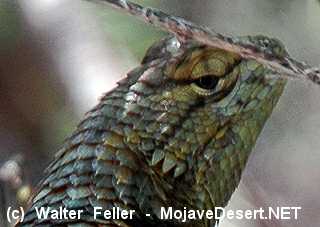Desert Spiny Lizard
Sceloporus magister
Family: Phrynosomatidae Order: Squamata Class: Reptilia
DISTRIBUTION, ABUNDANCE, AND SEASONALITY
In California, the desert spiny lizard is widely distributed throughout the Mojave,
Sonoran and Colorado deserts, as well as parts of the Great Basin and
and Central California Coast, in arid and semiarid environments. Its elevational
range extends from sea level to 2130 m (7000 ft) (Macey and Papenfuss 1991). This species
occurs in a variety of habitats, especially Joshua tree, palm oasis, desert succulent shrub,
and desert wash, usually in rocky areas. It is active from April to October (Stebbins 1954,
Oliver 1955, Tanner and Krogh 1973).
SPECIFIC HABITAT REQUIREMENTS
Feeding:
This lizard eats primarily insects; ants, beetles, flies, grasshoppers; other
lizards and some plant material (Stebbins 1954).
Cover:
Where rocks are present they are used for cover. Yucca, trees, and various
shrubs are used for perches and cover when rocks are not present (Stebbins 1954).
Reproduction: This species presumably lays eggs in nests constructed in friable,
sandy, well-drained soil.
Water:
Water probably not required.
Pattern:
This species occurs in a variety of habitats that provide rocks, Yucca, trees
or shrubs for perches. This lizard spends much of its time on elevated perches, from
which it forages and engages in social communication.
SPECIES LIFE HISTORY
Activity Patterns:
This lizard becomes active early in the spring, usually by April, and
remains active until October. Higher-elevation populations become active a little later.
The lizards are diurnal and remain active, or at least visible, on conspicuous elevated
perches throughout the day. During the hottest weather they may retreat to cover in
the middle of the day.
Seasonal Movements/Migration:
None.
Home Range:
This species achieves densities of 6-50 per ha (2-20 per ac) in creosote
habitats.
Territory:
This species has a complex social organization and is probably territorial.
Reproduction:
This species breeds from May to June. Clutch size averages 10 and
ranges from 7-18 eggs (Stebbins 1954, Tanner and Krogh 1973).
Niche:
There are no reports of predation on this species but it is probably eaten by
predatory birds and snakes. The young are probably taken by predatory lizards (Gambelia
and Crotaphytus).
REFERENCES
Macey, J. R. and T. J. Papenfuss. 1991. Reptiles. Pages 291-360 in C.A. Hall, Jr., editor.
Natural History of the White-Inyo Range eastern California. Univ. Calif. Press, Berkeley,
California. 536 pp.
Oliver, J. A. 1955. The natural history of North American amphibians and reptiles. Van
Nostrand Co. Princeton, NJ. 359pp.
Parker, W. S. 1982. Sceloporus magister. Cat. Am. Amphibians and Reptiles 290.
Stebbins, R. C. 1954. Amphibians and reptiles of western North America. McGraw-Hill,
New York. 536pp.
Tanner. W. W., and J. E. Krogh. 1973. Ecology of Phrynosoma platyrhinos at the Nevada
Test Site, Nye County, Nevada. Herpetologica 29:327-342.
California Department of Fish and Game. California Interagency
Wildlife Task Group. 2005. California Wildlife Habitat Relationships version 8.1 personal computer
program. Sacramento, California.

Desert Spiny Lizard